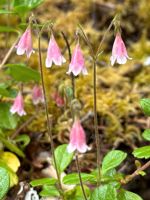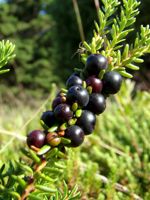Mon-Fri 9am - 5pm Mountain time
Twinflower vs Black Crowberry
Linnaea borealis
Empetrum nigrum
CUSTOM GROW
CUSTOM GROW
Twinflower is a native, trailing evergreen ground cover known for its delicate flowers that grow in nodding pairs. These pale pink blooms are described as being sweetly fragrant, attracting native bees and other pollinators.
Growing in cool, moist, acidic soils, the trailing stems form roots as they spread and start to form mats across the forest floor. Due to its woody stem, it is technically classified as a shrub and often referred to as a subshrub or dwarf shrub. This species is well-suited for naturalization, restoration, and conservation projects.
Twinflower (Linneae borealis) was named in honour of Carl Linnaeus, who adopted it as his personal emblem.
Black Crowberry is a native evergreen shrub that forms low, spreading mats. It has unique foliage that spirals around the stem, and small dark berries, giving it visual appeal. The berries are edible, but can be acidic, so they are not generally eaten fresh. In colder climates, the berries develop a sweet-tart flavor and are often dried or used in desserts, jams, and jellies.
This hardy shrub provides food for birds and mammals, while its flowers attract pollinators such as bees. It also serves as a host plant for certain butterflies and moths. Together, these roles make it a key contributor to the health of tundra and boreal ecosystems.
In Newfoundland and Labrador, the berries are known locally as ‘blackberries’ and are enjoyed in jams, jellies, and traditional baked goods such as buns and puddings. In Scandinavia, they continue to be used in liqueurs, wines, and juices.

